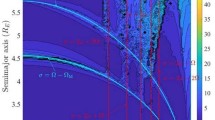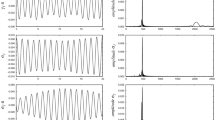Abstract
In this work, two dynamical models are formulated to describe the secular dynamics of navigation satellites moving in the medium Earth orbit (MEO) and geosynchronous orbit (GSO) regions. In the dynamical models, the leading terms of the Earth’s oblateness and the luni-solar gravitational perturbations are considered. For convenience, the orbits of the Sun and the Moon are described in the geocentric ecliptic reference frame, where the regression of nodal line and precession of apsidal line of the lunar orbit can be approximated as linear functions of time. The disturbing function acting on navigation satellites is analytically averaged over the mean motions of both the satellite and the third body (the Sun or the Moon). Explicit expressions of the averaged disturbing function are provided in the geocentric ecliptic and equatorial reference frames, corresponding to averaged model 1 and averaged model 2, respectively. It is found that there are seven resonant arguments in averaged model 1, while there are thirty-two resonant arguments in averaged model 2. The associated resonance curves corresponding to these resonant arguments in each model form the dynamical backbone in the phase space, organizing secular behavior of navigation satellites. At last, the averaged models are numerically compared to the associated non-averaged model, and simulation results indicate that (a) the averaged models formulated in the geocentric ecliptic and equatorial reference frames are identical, and (b) both of these two averaged models are applicable in predicting secular behavior of navigation satellites.
Similar content being viewed by others
Change history
11 February 2022
A Correction to this paper has been published: https://doi.org/10.1007/s42064-022-0136-2
References
Broucke, R. A. Long-term third-body effects via double averaging. Journal of Guidance, Control, and Dynamics, 2003, 26(1): 27–32.
Bertachini de Almeida Prado, A. F. Third-body perturbation in orbits around natural satellites. Journal of Guidance, Control, and Dynamics, 2003, 26(1): 33–40.
Domingos, R. C., de Moraes, R. V., de Almeida Prado, A. F. B. Third-body perturbation in the case of elliptic orbits for the disturbing body. Mathematical Problems in Engineering, 2008, 2008: 1–14.
Liu, X. D., Baoyin, H. X., Ma, X. R. Long-term perturbations due to a disturbing body in elliptic inclined orbit. Astrophysics and Space Science, 2012, 339(2): 295–304.
Nie, T., Gurfil, P., Zhang, S. J. Semi-analytical model for third-body perturbations including the inclination and eccentricity of the perturbing body. Celestial Mechanics and Dynamical Astronomy, 2019, 131(6): 29.
Lei, H. L., Circi, C., Ortore, E. Modified double-averaged Hamiltonian in hierarchical triple systems. Monthly Notices of the Royal Astronomical Society, 2018, 481(4): 4602–4620.
Kozai, Y. The motion of a close earth satellite. The Astronomical Journal, 1959, 64: 367.
Kozai, Y. Secular perturbations of asteroids with high inclination and eccentricity. The Astronomical Journal, 1962, 67: 591.
Naoz, S., Farr, W. M., Lithwick, Y., Rasio, F. A., Teyssandier, J. Secular dynamics in hierarchical three-body systems. Monthly Notices of the Royal Astronomical Society, 2013, 431(3): 2155–2171.
Naoz, S. The eccentric kozai-lidov effect and its applications. Annual Review of Astronomy and Astrophysics, 2016, 54(1): 441–489.
Scheeres, D. J., Hu, W. Secular motion in a 2nd degree and order-gravity field with no rotation. Celestial Mechanics and Dynamical Astronomy, 2001, 79(3): 183–200.
Hu, W., Scheeres, D. J. Spacecraft motion about slowly rotating asteroids. Journal of Guidance, Control, and Dynamics, 2002, 25(4): 765–775.
Lei, H. L., Circi, C., Ortore, E., Condoleo, E., Xu, B. Quasi-frozen orbits around a slowly rotating asteroid. Journal of Guidance, Control, and Dynamics, 2019, 42(4): 794–809.
Paskowitz, M. E., Scheeres, D. J. Design of science orbits about planetary satellites: Application to europa. Journal of Guidance, Control, and Dynamics, 2006, 29(5): 1147–1158.
Lei, H. L., Circi, C., Ortore, E. Secular dynamics around uniformly rotating asteroids. Monthly Notices of the Royal Astronomical Society, 2019, 485(2): 2731–2743.
Condoleo, E., Cinelli, M., Ortore, E., Circi, C. Frozen orbits with equatorial perturbing bodies: The case of ganymede, callisto, and titan. Journal of Guidance, Control, and Dynamics, 2016, 39(10): 2264–2272.
Circi, C., Condoleo, E., Ortore, E. A vectorial approach to determine frozen orbital conditions. Celestial Mechanics and Dynamical Astronomy, 2017, 128(2–3): 361–382.
Yokoyama, T. Dynamics of some fictitious satellites of Venus and Mars. Planetary and Space Science, 1999, 47(5): 619–627.
Sinclair, A. T. The motions of the satellites of mars. Monthly Notices of the Royal Astronomical Society, 1971, 155(2): 249–274.
Zhao, C. Y., Zhang, M. J., Wang, H. B., Xiong, J. N., Zhu, T. L., Zhang, W. Analysis on the long-term dynamical evolution of the inclined geosynchronous orbits in the Chinese BeiDou navigation system. Advances in Space Research, 2015, 56(3): 377–387.
Tang, J. S., Hou, X. Y., Liu, L. Long-term evolution of the inclined geosynchronous orbit in Beidou Navigation Satellite System. Advances in Space Research, 2017, 59(3): 762–774.
Daquin, J., Rosengren, A. J., Alessi, E. M., Deleflie, F., Valsecchi, G. B., Rossi, A. The dynamical structure of the MEO region: Long-term stability, chaos, and transport. Celestial Mechanics and Dynamical Astronomy, 2016, 124(4): 335–366.
Zhu, T. L. On the lunar node resonance of the orbital plane evolution of the Earth’s satellite orbits. Advances in Space Research, 2018, 61(11): 2761–2776.
Rosengren, A. J., Alessi, E. M., Rossi, A., Valsecchi, G. B. Chaos in navigation satellite orbits caused by the perturbed motion of the Moon. Monthly Notices of the Royal Astronomical Society, 2015, 449(4): 3522–3526..
Lane, M. T. On analytic modeling of lunar perturbations of artificial satellites of the earth. Celestial Mechanics and Dynamical Astronomy, 1989, 46(4): 287–305..
Celletti, A., Galeş, C., Pucacco, G., Rosengren, A. J. Analytical development of the lunisolar disturbing function and the critical inclination secular resonance. Celestial Mechanics and Dynamical Astronomy, 2017, 127(3): 259–283..
Lara, M., San-Juan, J. F., López, L. M., Cefola, P. J. On the third-body perturbations of high-altitude orbits. Celestial Mechanics and Dynamical Astronomy, 2012, 113(4): 435–452.
Ulivieri, C., Circi, C., Ortore, E., Bunkheila, F., Todino, F. Frozen orbital plane solutions for satellites in nearly circular orbit. Journal of Guidance, Control, and Dynamics, 2013, 36(4): 935–945.
Circi, C., Condoleo, E., Ortore, E. Moon’s influence on the plane variation of circular orbits. Advances in Space Research, 2016, 57(1): 153–165.
Musen, P. On the long-period lunisolar effect in the motion of the artificial satellite. Journal of Geophysical Research, 1961, 66(6): 1659–1665.
Brouwer, D. I. R. K., Clemence, G. M. Methods of Celestial Mechanics. Elsevier, 1961.
Harrington, R. S. The stellar three-body problem. Celestial Mechanics, 1969, 1(2): 200–209.
Delhaise, F., Morbidelli, A. Luni-solar effects of geosynchronous orbits at the critical inclination. Celestial Mechanics & Dynamical Astronomy, 1993, 57(1–2): 155–173.
Rosengren, A. J., Scheeres, D. J. Long-term dynamics of high area-to-mass ratio objects in high-Earth orbit. Advances in Space Research, 2013, 52(8): 1545–1560.
Callegari, N. Jr, Yokoyama, T. Some aspects of the dynamics of fictitious Earth’s satellites. Planetary and Space Science, 2001, 49(1): 35–46.
Baoyin, H. X., Liu, X. D., Beauvalet, L. Analysis of potential locations of asteroidal moonlets. Monthly Notices of the Royal Astronomical Society, 2013, 430(4): 3483–3488.
Murray, C. D., Dermott, S. F. Solar System Dynamics. Cambridge: Cambridge University Press, 1999.
Chirikov, B. V. A universal instability of many-dimensional oscillator systems. Physics Reports, 1979, 52(5): 263–379.
Cardoso dos Santos, J., Carvalho, J. P. S., Prado, A. F. B. A., Vilhena de Moraes, R. Lifetime maps for orbits around Callisto using a double-averaged model. Astrophysics and Space Science, 2017, 362(12): 227.
Tresaco, E., Carvalho, J. P. S., Prado, A. F. B. A., Elipe, A., de Moraes, R. V. Averaged model to study long-term dynamics of a probe about Mercury. Celestial Mechanics and Dynamical Astronomy, 2018, 130(2): 9.
Ely, T. A., Howell, K. C. Dynamics of artificial satellite orbits with tesseral resonances including the effects of luni-solar perturbations. Dynamics and Stability of Systems, 1997, 12(4): 243–269.
Fehlberg E. Technical report NASA TR R-287, Classical fifth-, sixth-, seventh-, and eighth-order Runge-Kutta formulas with stepsize control. NASA Marshall Space Flight Center, 1968.
Acknowledgements
This work is performed with the financial support of the Natural Science Foundation of Jiangsu Province (No. BK20160612), the National Natural Science Foundation of China (Nos. 11603011, 41774038) and the National Defense Scientific Research Fund (No. 2016110C019). The author thanks Prof. Xiyun Hou for helpful discussions on the different dynamical structures in the geocentric ecliptic and equatorial reference frames and anonymous reviewers for their valuable comments that substantially improve the quality of the present work.
Author information
Authors and Affiliations
Corresponding author
Additional information
Hanlun Lei received his Ph.D. degree in astronomy from Nanjing University, China, in 2015. Currently, he is an associate professor at School of Astronomy and Space Science in Nanjing University. His research interest focuses on astrodynamics and celestial mechanics, including periodic orbits and space manifold dynamics in multi-body environments, as well as resonance dynamics of minor bodies in the solar system.
Rights and permissions
About this article
Cite this article
Lei, H. Dynamical models for secular evolution of navigation satellites. Astrodyn 4, 57–73 (2020). https://doi.org/10.1007/s42064-019-0064-y
Received:
Accepted:
Published:
Issue Date:
DOI: https://doi.org/10.1007/s42064-019-0064-y




